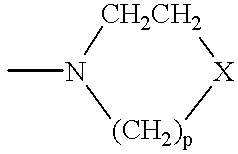Method for treating tension-type headache with inhibitors of nitric oxide and nitric oxide synthase
a technology of nitric oxide and nitric oxide synthase, which is applied in the direction of biocide, anhydride/acid/halide active ingredients, peptide/protein ingredients, etc., can solve the problems of tension-type headache, inability to detect an increase in electromyography (emg) measurements, and inability to achieve the effect of reducing neuronal transmission
- Summary
- Abstract
- Description
- Claims
- Application Information
AI Technical Summary
Problems solved by technology
Method used
Image
Examples
example 1
Experimental Evidence For Central Sensitization in Chronic Myofascial Pain
The study was performed in order to investigate the pathophysiology of myofascial tenderness which has consistently been reported to be increased in patients with tension-type headache (Lous and Olesen 1982; Langemark and Olesen 1987, Jensen et al. 1993b). Recently, it was suggested that myofascial tenderness may be the result of a lowered pressure pain threshold, a stronger response to pressures in the noxious range (as illustrated by a steeper stimulus-response function) or a combination of both (Jensen 1990b). The aim of the study therefore was to investigate the stimulus-response function for pressure versus pain in patients with tension-type headache. The methods and the results of the study will be described in the following.
Materials and Methods
Patients and Controls
Forty patients with chronic tension-type headache diagnosed according to the criteria of the International Headache Society (1988) were exam...
example 2
Mechanisms of Spontaneous Tension-type Headaches
An analysis of tenderness, pain thresholds and EMG
Pericranial muscle tenderness, EMG-levels and thermal and mechanical pain thresholds were studied in 28 patients with tension-type headache and in 30 healthy controls. Each patient was studied during as well as outside a spontaneous episode of tension-tape headache. Outside of headache muscle tenderness and EMG-levels were significantly increased compared to values in controls subjects, while mechanical and thermal pain thresholds were largely normal. During headache muscle tenderness evaluated by blinded manual palpation increased significantly, while pressure pain thresholds remained normal and pressure pain tolerances decreased. Thermal pain detection and tolerance threshold decreased significantly in the temporal region, but remained normal in the hand. EMG-levels were unchanged during headache. The findings indicate that one of the primary sources of pain in tension-type headache m...
example 3
Initiating Mechanisms of Experimentally Induced Tension-type Headache
To elucidate possible myofascial mechanisms of tension-type headache, the effect of 30 minutes of sustained tooth clenching (10% of maximal EMG-signal) was studied in 58 patients with tension-type headache and in 30 age and sex matched controls. Pericranial tenderness, mechanical and thermal pain detection and tolerance thresholds and EMG levels were recorded before and after the clenching procedure. Within 24 hours 69% of patients and 17% of controls developed a tension-type headache. Shortly after clenching, tenderness was increased in the group who subsequently developed headache, whereas tenderness was stable in the group of patients who remained headache free. Mechanical pain thresholds evaluated by pressure algometry remained unchanged in the group which developed headache, whereas thresholds increased in the group which did not develop headache Thermal pain detection and tolerance thresholds remained unchang...
PUM
| Property | Measurement | Unit |
|---|---|---|
| treatment time | aaaaa | aaaaa |
| diameter | aaaaa | aaaaa |
| time | aaaaa | aaaaa |
Abstract
Description
Claims
Application Information
 Login to View More
Login to View More - R&D
- Intellectual Property
- Life Sciences
- Materials
- Tech Scout
- Unparalleled Data Quality
- Higher Quality Content
- 60% Fewer Hallucinations
Browse by: Latest US Patents, China's latest patents, Technical Efficacy Thesaurus, Application Domain, Technology Topic, Popular Technical Reports.
© 2025 PatSnap. All rights reserved.Legal|Privacy policy|Modern Slavery Act Transparency Statement|Sitemap|About US| Contact US: help@patsnap.com



